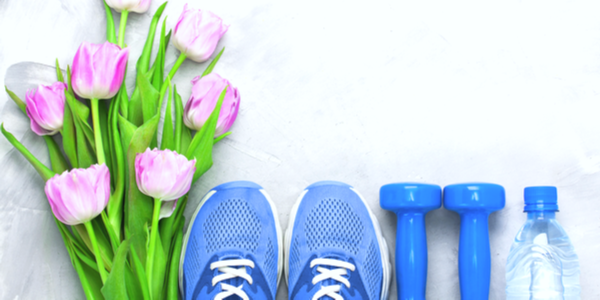
As the season shifts from winter to spring, so too can habits. Not only does winter promote hibernation from the cold, but it can also contribute to lackluster health habits.
So as spring cleaning commences this year, extend it beyond the home and into health as well. This is a comprehensive guide on how to stay healthy and other health tips for the spring season!
Importance of Setting Goals
The first step of any new health endeavor is goal setting. Setting clear goals provides direction and serves as a way to monitor and evaluate progress.
One of the simplest ways to distinguish aspirations is through creating SMART goals, where SMART stands for: Specific, Measurable, Achievable, Realistic, Timely. SMART goals incorporate these criteria to help focus efforts and increase the chances of achieving them.
Often, individuals inadvertently set themselves up to fail by setting generic or unrealistic goals. However, developing SMART goals reduces this chance greatly.
Here are two examples of how to create a general goal into a SMART one:
General: "I will eat healthier."
SMART version: "I will eat a fruit or veggie with every meal four days out of the week to improve my physical health."
General: "I will get in shape."
SMART version: "I will commit to doing cardio for thirty minutes two days a week and strength training two days a week for the next 6 months to improve my endurance and strength."
Check Personal Health
After setting clear goals, it is prudent to check overall health status in order to gauge the baseline starting point. There are various ways to check health but the most important part is to be comprehensive.
Here are 4 measures of health to acquire, ideally, before diving into spring health endeavors.
Get a Physical
This is a fairly easy way to obtain a thorough report of current health. It includes vital signs like blood pressure, heart rate, breathing rate, temperature, height, and weight. Examinations and inspections of the head, eyes, ears, nose, and throat may be appropriate as well.
The physical examiner will also assess health history including lifestyle behaviors, smoking, alcohol use, sexual health, diet, exercise, and disease history. This comprehensive assessment provides an accurate picture of current general health status.
Check Blood Work
A more internal look at health, blood work can reveal important measures of health over time. The most common blood panels include:
• Lipid panels to measure HDL and LDL cholesterol
• Basic metabolic panel (BMP) to check glucose, calcium, electrolytes, potassium, carbon dioxide, sodium, chloride, creatinine, and BUN
• Complete metabolic panel including BMP and liver function measurements
• Comprehensive urinalysis to assess content and concentration of urine
• Thyroid panel to check metabolism, growth hormones, body temperature, heart rate, and other hormones
• Complete blood count to measure a range of white and red blood cells, platelets, hemoglobin, and hematocrit; prothrombin time to assess how long it takes blood to clot
Look Into At-Home Body Scans
One of the most preventative health checks, at-home body scans consist of palpating the body in specific areas. The purpose is to check for lumps, moles, or any other signs of potential dysfunction.
Consult with a doctor about any unusual findings.
Care for Mental Health
Although often less discussed, mental/emotional health is just as important as physical. Unfortunately, there are no concrete mental health exams or even validated check-ins.
However, one can regularly gauge their own mental health in a variety of ways such as with a therapist or counselor. Journaling, meditating, being creative, and talking with trusted friends and family can also be helpful.
How to Become More Active
Physical activity does not only cater to weight management and reduced risk of chronic disease. Exercise also contributes to improved mood, boosted energy and sleep, social connection, and enhanced immunity.
One of the easiest ways to stay active is to prioritize walking throughout the day. This may mean taking the dog on a walk or simply parking further away from the grocery store.
Five additional ways to become more active include:
1. Commit and plan to exercise or obtain 30 minutes of active minutes 4-5 days a week up to 6 when possible.
2. Park in the furthest lots of shopping centers, appointments, grocery stores, etc.
3. Prioritize household chores most days of the week (vacuuming, dusting, walking laundry upstairs, sweeping, tidying up rooms).
4. Adopt a new active hobby such as a recreational sport, gardening, yoga, stretching, hiking, horseback riding, etc.
5. Perform lymphatic massages and draining techniques to move the fluids inside the body. Doing so is equally as important as moving the physical body for a strong immune system and metabolic health.
Eat the Right Food
A not-so underrated health practice, eating healthfully mains vitality and increases life span and quality of life considerably. Although, with so many claims and diet trends circulating the ether, it can be difficult to discern the truth.
However, the following approved tips undoubtedly promote internal and external health.
1. Limit refined and processed sugar.
Except for the truly special occasion, avoid foods with more than 5 grams of added sugar. Also aim to eat carbohydrate sources in their whole and purest form.
Healthy carb choices include whole wheat grains, quinoa, sourdough, lentils, beans, legumes, and starchy vegetables.
2. Consume enough lean protein every day.
Eating enough protein helps with satiation, builds and preserves muscle tissue, and supports a healthy metabolism. Protein also repairs and develops all cells in the body.
The most nutritious lean protein sources include animal products such as grass-fed meat, poultry, dairy, and eggs; fatty fish like salmon, sardines, anchovies, and other seafood. Plant-based sources include beans, lentils, and legumes, tofu, seitan, and tempeh.
3. Prioritize healthy fats.
The most nutritious fat sources boast omega-3 fatty acids. They are also monounsaturated, although some amount of omega-6 and polyunsaturated fats are necessary.
Some of the highest sources of monounsaturated, omega-3 fatty acids include:
• Avocado
• Chia and flax seeds
• Cod liver oil
• Fatty fish such as anchovies herring, salmon, sardines
• Oysters
• Soybeans
Other high contenders are pasture-raised eggs, grass-fed meat and animal products, hemp seeds, and various other nuts and seeds.
4. Eat the recommended 5 to 9 servings of fruits and vegetables per day.
Fruits and veggies contain healthy forms of carbohydrate, protein, and fat. They also boast plenty of beneficial plant polyphenols that confer cellular and metabolic health benefits.
Plus, as fruit and vegetable intake increases, poor food choices tend to decrease.
5. Supplement as needed.
Supplements help fill in the gaps of an already healthy diet to prevent nutrient deficiencies. The best spring supplements include:
• Vitamin A for healthy skin and aging
• A vitamin B complex for maintaining energy levels and managing stress
• Vitamin C for a natural antioxidant, to enhance collagen production, and because it is a natural antihistamine (antidote for allergies)
• Vitamin D because many people are deficient after staying inside all Winter and to ensure healthy bones, teeth, and muscles
Consult with a health professional if interested in taking a supplement to find the best fit.
Stay Hydrated
Water makes up 60 to 70 percent of total human body weight. Every cell depends on water to function optimally and the body requires it to:
• Rid of waste properly
• Keep adequate temperature ranges
• Lubricate and cushion joints
• Protect sensitive tissues
What's more, preventing dehydration ensures sufficient exercise performance, energy levels, and overall well-being.
Thus, The U.S. National Academies of Sciences, Engineering and Medicine determined adequate daily fluid intake for men is about 15.5 cups (3.7 liters) per day. Women are recommended to about 11.5 cups (2.7 liters) daily.
Other factors can also influence water needs. This includes certain disease states, exercise patterns, and where one resides to name a few.
Final Thoughts
Staying healthy this spring need not be complicated. After establishing clear and strategic goals and receiving a baseline health report, the simplest ways to adopt healthy habits are through diet, exercise, and hydration.
Using the provided guidelines, staying healthy this spring will be as breezy as the refreshing springtime air!
References:
7 great reasons why exercise matters. Mayo Clinic. Published May 11, 2019. http://www.mayoclinic.org/healthy-lifestyle/fitness/in-depth/exercise/art-20048389.
How much water do you need to stay healthy? Mayo Clinic. Published October 14, 2020. http://www.mayoclinic.org/healthy-lifestyle/nutrition-and-healthy-eating/in-depth/water/art-20044256#:~:text=The%20U.S.%20National%20Academies%20of,fluids%20a%20day%20for%20women.
SMART Goal - Definition, Guide, and Importance of Goal Setting. Corporate Finance Institute. Published September 16, 2020. https://corporatefinanceinstitute.com/resources/knowledge/other/smart-goal/.







